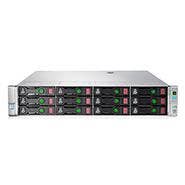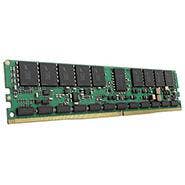HPE Adds Broadwell Processors, Persistent Memory To Gen9 ProLiant Servers

HPE Thursday updated its ProLiant Gen9 server portfolio with the introduction of Intel's newest Broadwell processor as well as its new persistent memory technology, which allows the server's memory to serve as a high-performance storage tier.
The latest versions of HPE's Gen9, or ninth generation, ProLiant DL360 and DL380 servers also include new management, security and storage capabilities aimed at helping customers tie on-premise data center infrastructures to the cloud for running mission-critical applications, said Tom Lattin, HPE's vice president of server options.
"This is an introduction for a new set of capabilities for our ProLiant Gen 9 servers," Lattin told CRN. "We're bringing in a new memory architecture, a new architecture for migrating solutions to the cloud, higher performance and higher security, in addition to our new persistent memory technology."
[Related: HPE Intros 'Persistent Memory,' Combining DRAM Speed With NAND Flash Persistence]
The new servers come as HPE is really making its presence felt in the server market, said Mike Carter, president and founder of eGroup, a Mt. Pleasant, S.C.-based solution provider and HPE channel partner.
"In general, we've seen a heightened and pronounced presence from HPE in the last six months," Carter said. "HPE had almost been invisible for a while as Cisco UCS and VCE took the center stage."
The updated ProLiant DL360 and ProLiant DL380 servers are based on Intel's new Xeon E5-2600 v4 processors, which were formally introduced Thursday by Intel at the Intel Solutions Summit, held this week in Orlando, Fla.
The new Xeon E5-2600 v4 processors, code-named Broadwell, give the new Gen9 ProLiants a significant boost in performance, Lattin said.
The servers also come with the first implementation of HPE's persistent memory technology.
Introduced Tuesday, persistent memory brings together standard DRAM along with NAND flash memory and a micro controller with an integrated battery on a module that fits in a standard memory slot, said Bret Gibbs, persistent memory product manager at HPE, Palo Alto, Calif.
"We're looking to deliver the performance levels you see with DRAM, but in the realm of meeting storage requirements," Gibbs told CRN.

Its first implementation, the NVDIMM, which is short for "non-volatile DIMM," pairs 8 GB of DRAM for pure speed with 8 GB of NAND flash for persistence. Future versions will be available in different capacity points.
Because of the on-board DRAM, NVDIMM performance is the same as DRAM, HPE's Gibbs said. However, when compared to SAS SSDs and PCIe-based storage, NVDIMM offers 24 times the IOPS and six times the bandwidth, with 73 times lower latency, he said.
NVDIMM is tied closely to the software used in servers, Gibbs said. "The operating system will see NVDIMM as block storage, as if it's hard disk or SSD capacity," he said. To get full performance, applications will need to be modified to address NVDIMM. Unmodified applications will see increased performance, but there will be a huge difference in applications that are modified."
Microsoft plans to show how NVDIMM technology works with its applications, Gibbs said. HPE is also offering a software development kit for Linux developers to get their applications ready to work with NVDIMM, he said.
Initial target workloads for NVDIMM will be database applications, Gibbs said.
NVDIMM, which is based on industry standards, already has other implementations in the market, Gibbs said. "But this is the first to be designed for a specific server," he said. "Our NVDIMM is tied to HPE's Smart Storage Battery, which acts as the battery backup to the DIMMs."
HPE 8-GB NVDIMM modules will be list-priced at $899. This compares with about $249 for a standard RDIMM module, HPE said.
The ProLiant DL360 and DL380 have proven to be real enterprise workhorses, and the new persistent memory will make them even more so, eGroup's Carter said.
"The volatility of RAM has been an issue," he said. "Persistent memory seems to be the right ticket for improving performance."
NVDIMM will be key to running important data in memory and knowing that the data can't be lost, said Dan Molina, chief technology officer at Nth Generation Computing, a San Diego-based solution provider and longtime HPE partner.
Customers with mission-critical applications such as Oracle and Microsoft SQL databases would like to use persistent memory to run those applications, Nth Generation's Molina told CRN.
"If they are run in memory that acts like storage, they will run dramatically faster," he said. "Customers could also fit part of an application like transactional logs in persistent memory, which would still provide important performance benefits."
In addition to the Intel Xeon E5-2600 v4 processors and HPE's persistent memory technology, the updated Gen9 ProLiant servers have a number of other memory advances, HPE's Lattin said.
They now offer the option of DDR4 2400MT/s memory in addition to the previous top-performing 2100MHz memory, he said.
Customers can now also use memory modules with up to 128-GB capacity per module compared with the previous maximum of 64 GB per module. "Customers can now run an entire workload in memory," he said. "Customers have already started doing so. But for applications which were capacity-bound, we eliminated the boundary by doubling the capacity of the DIMMs."
HPE is also moving to Trusted Platform Module 2.0 with the updated ProLiant servers, Lattin said. This is the latest version of the TPM specification for a dedicated microprocessor that integrates cryptographic keys into hardware to decrease the risk of cyberattacks.